Scott Pickett's favourite winter recipes
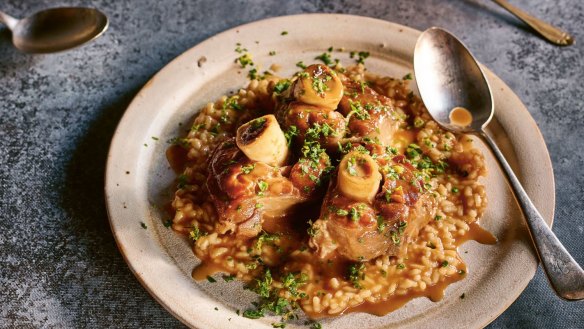
Chef and restaurateur Scott Pickett, who has made his name with Melbourne restaurants such as Estelle, Matilda 159 and Saint Crispin, says one of the toughest questions he's asked is, "Which season is your favourite?". Answer: he loves them all, for different reasons.
In his latest cookbook, Marriage of Flavours, Pickett shares some of his favourite seasonal dishes, exploring what makes some flavour combinations click and imparting tips and tricks gleaned from more than two decades spent in top kitchens. These are some of the dishes that help him through the cold bite of winter.
Ossobuco with risotto milanese
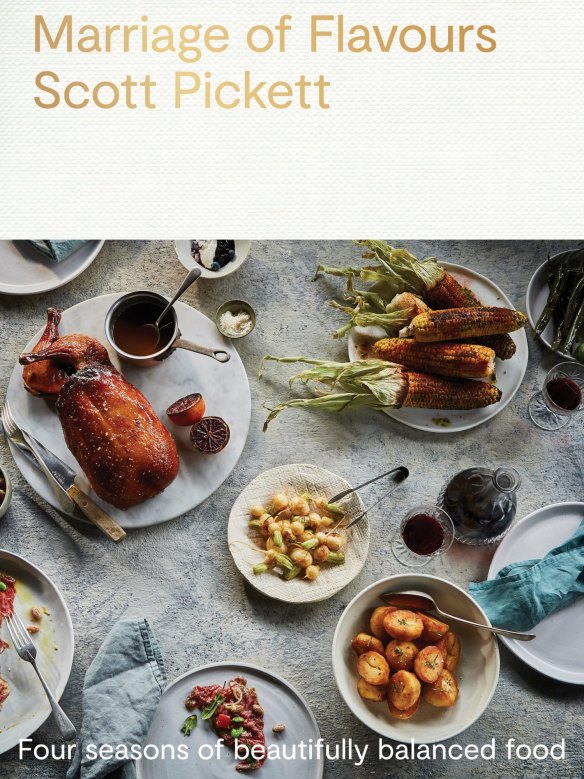
One of the most famous dishes from Milan, the key ingredient in this risotto (aside from the rice) is saffron. Traditionally bone marrow is stirred back into it to make it glossy. It's a perfect foil for the slow-cooked veal, and a hearty winter night's feast. The classic way to serve this is to scatter it with the gremolata, which adds a wonderful freshness to the dish: the garlic, parsley and lemon work brilliantly with the tomato, meat and saffron.
INGREDIENTS
Ossobuco
1kg ripe tomatoes
4 × 350-450g slices veal ossobuco
¼ cup olive oil
2 cloves garlic, finely sliced
2 brown onions, diced
2 anchovies, chopped
250ml dry white wine
2 litres veal or chicken stock
1 large sprig thyme
1 large sprig rosemary
1 large sprig sage
1 bay leaf
good pinch of saffron
Gremolata
½ bunch flat-leaf parsley, leaves picked and chopped
finely grated zest of 2 lemons
1 garlic clove, finely grated
Risotto
50ml olive oil
5 golden shallots, finely diced
2 cloves garlic, crushed
500g carnaroli or arborio rice
pinch of saffron
50g parmesan, grated
25g butter
2 tbsp olive oil
½ lemon (optional)
sea salt
freshly ground black pepper
METHOD
1. For the ossobuco, score a cross in the base of each tomato and place into a large heatproof bowl. Cover with boiling water and stand for two minutes, then drain. When cool enough to handle, slip off the skins. Cut in half crossways and scoop out the seeds, then roughly chop the flesh.
2. Season the meat well on both sides with salt and pepper. Heat two tablespoons of the olive oil in a large flameproof casserole over high heat. Sear the meat on both sides until well browned, then set aside. Reduce heat to low and heat the remaining olive oil. Add the garlic to the pan and cook until caramelised, then add the onion and anchovies and cook until tender.
3. Add the tomato to the pan and increase the heat to medium. Cook, stirring often, until the tomatoes have softened and broken down. Pour in the white wine and cook until reduced by two-thirds. Add the stock, herbs and saffron and bring to the boil.
4. Preheat the oven to 160C. Return the meat to the pan and submerge in the liquid. Cover with a lid or foil and bake for 2-2 ½ hours, until the meat is just coming away from the bone. Allow the meat to rest in the cooking liquid until lukewarm, then transfer to a plate, cover and set aside. Strain the cooking liquid through a fine sieve, pressing on the vegetables to extract as much as possible. Place one litre of the stock in a saucepan for the risotto. Put the rest back into the casserole and return the meat. Reheat in a low oven while you make the risotto.
5. For the gremolata, mix the ingredients in a small bowl and set aside.
6. To make the risotto, heat the reserved stock over medium-low heat and keep warm. Heat the olive oil in a wide saucepan over medium heat. Add the shallots and garlic and cook until tender. Add the rice and toast until lightly browned, then stir in the saffron. Add the hot stock a ladle at a time, stirring constantly and making sure it is fully incorporated before adding more. It will take about 25 minutes to cook the rice, adding stock and stirring, until it is creamy but the grains still have a slight bite. Stir the parmesan and butter into the risotto, with the olive oil and a squeeze of lemon juice if you like. Season to taste.
7. Serve the ossobuco with the risotto, scattered with gremolata.
Serves 4
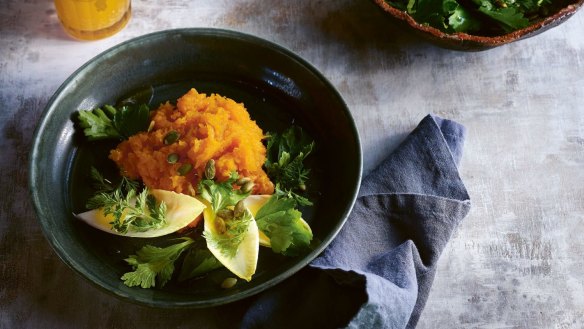
Curried pumpkin mash, herb salad
As chefs we always look for a bit of texture in a dish – some crunch certainly does make the eating experience a whole lot better. The salad we serve with this pumpkin mash does just that: it lightens up the dish, adds some texture and the acid helps cut through the richness of the buttery mash.
INGREDIENTS
250g butter
2 medium butternut pumpkins
sea salt
2 tbsp curry powder
¼ cup pumpkin seeds, toasted
½ cup flat-leaf parsley leaves
½ cup celery leaves
½ cup carrot tops (optional)
½ witlof, leaves separated
Pumpkin dressing
100ml pumpkin seed oil
50ml olive oil
50ml champagne vinegar
1 clove garlic, finely chopped
1 golden shallot, finely chopped
METHOD
1. To make the pumpkin dressing, combine the pumpkin seed oil, olive oil and champagne vinegar in a small bowl. Add the garlic and shallot and whisk to combine. Cover and refrigerate until needed (it will keep for up to two days).
2. Place the butter in a saucepan over medium heat. Cook the butter until brown (145C is the perfect temperature for brown butter). Pass it through a fine sieve into a mixing bowl. Reserve.
3. Meanwhile, remove the top and bottom from each pumpkin, and cut off the skin. Cut the flesh into small cubes and discard the seeds and membrane. Place in a large steamer basket over a pan of boiling water (or cook in batches if your steamer is small). Cook for 10 minutes or until tender but not mushy – be careful to leave some texture or it will turn to a puree before your very eyes.
4. Transfer the pumpkin to a large bowl. Add the curry powder and 150ml of the brown butter. Season with salt, and use a potato masher to mash until smooth. The result should be a rich, buttery mash. Feel free to add all the brown butter if that is to your taste!
5. In another small mixing bowl combine the pumpkin seeds, parsley, celery, carrot tops and witlof. Dress the salad with pumpkin dressing to taste. Serve alongside the mash, or divide the mash onto plates and top with a small heap of salad to cut through the richness.
Serves 8
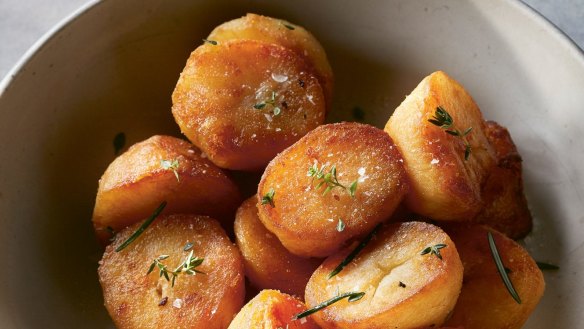
Duck fat roasted potatoes, herb salt
Is there anything tastier than an old school roast potato? My grandmother, Audrey, used to make the best ones I've ever tasted, and while I think mine are pretty special, they still don't match hers.
INGREDIENTS
1kg roasting potatoes
20g sea salt
1 tbsp black peppercorns
5 sprigs thyme
1 sprig rosemary
1 bay leaf
5 cloves garlic, unpeeled
200g duck fat
50ml olive oil
1 tbsp thyme leaves, picked
1 tbsp rosemary
Herb salt
1 tbsp rosemary, chopped
1 tsp dried thyme
1 tsp dried oregano
1 tsp dried basil
1 tsp freshly ground black pepper
250g salt
METHOD
1. To make the herb salt, mix all ingredients in a bowl.
2. Peel the potatoes and cut into large even-sized pieces, so they cook at the same rate. Place into a large saucepan with the salt, pepper, herb sprigs, bay leaf and garlic. Cover with plenty of water, place over medium heat and bring to a simmer. Cook the potatoes until they are tender. Be careful – they must be tender, but not falling apart. Gently drain the potatoes and spread out in a single layer on a tray. Leave in the fridge overnight, uncovered, in order to allow a slight skin to form on the outside.
3. Preheat the oven to 210C. Place a large roasting pan in the oven to heat. In a small saucepan, melt the duck fat with the olive oil until hot and combined.
4. When the roasting pan is very hot, add the oil mixture and then the potatoes. Toss the potatoes in the oil and return the pan to the oven for 15 to 20 minutes, or until the potatoes begin to form a lovely golden brown crust. Add the thyme leaves and rosemary, and stir the potatoes to expose the uncooked sides. Return to the oven and finish cooking for a further 10 to 15 minutes. Once the potatoes are a nice, crispy brown, season with herb salt and serve.
Note: This makes more herb salt than you will need for this recipe. It can be used to season just about anything. Store in an airtight container in a cool dark place for up to four weeks.
Serves 4-6
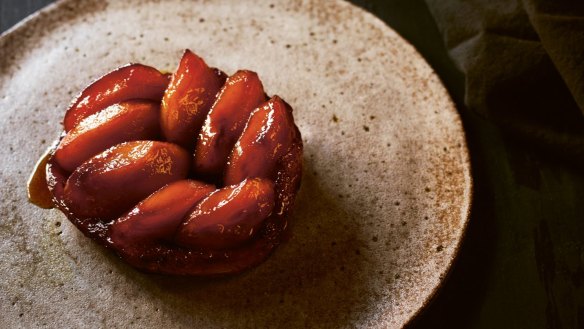
Apple tarte tatin, star anise ice-cream
One of my all-time favourite desserts. Nothing beats the golden pastry and roasty, slightly tart apple flavour with a rich, dark caramel. Add a big scoop of spiced star anise ice-cream and it's winter's delight!
INGREDIENTS
Star anise ice-cream
8 star anise
360ml milk
35g skim milk powder
750ml cream
150g egg yolks (about 7)
200g castor sugar
Apple tarte tatin
200g castor sugar
100g unsalted butter, chopped
4 large pink lady apples, peeled, quartered and cored
375g butter puff pastry, thawed
icing sugar, to dust
METHOD
1. To make the ice-cream, preheat the oven to 180C. Place the star anise on a baking tray and roast for six minutes, until fragrant. Combine the milk and star anise in a medium saucepan over medium heat. Add the milk powder and whisk until dissolved. Add the cream and bring just to the boil. Meanwhile, whisk the yolks and sugar together in a heatproof bowl until pale. Add one-third of the milk mixture to the yolk mixture and whisk to combine. Pour back into the pan with the remaining milk mixture. Stir over low heat until thickened (until a thermometer reaches 83C). Pass through a fine sieve into a bowl. Stand the bowl in a larger bowl of ice and stir to release the heat. Once cooled churn in an ice-cream machine. Transfer to an airtight container and freeze.
2. For the apple tarte tatin, preheat the oven to 190C. Add the sugar to a deep ovenproof frypan (25cm in diameter) and shake to make an even layer across the base. (Alternatively, you could use six to eight 13cm pans to make individual tartes.) Place over medium heat and melt the sugar without stirring until it has caramelised to an amber colour. Add the butter to the pan and mix until well combined. Set aside to cool slightly. Arrange the apple over the base of the pan, packing the pieces in as tightly as possible.
3. Cut a round from the pastry 2cm larger than the diameter of the frypan. Place over the apple and tuck the excess pastry down inside the pan.
4. Place the pan in the oven and bake for 25 minutes, until the pastry is puffed and golden. Stand for five minutes, so the caramel can cool and thicken slightly, making it safer and easier to turn out. Place a serving plate that is larger than the diameter of the pan on top and quickly invert. Be very careful, as hot caramel may spill out. Lift the pan off the tarte and stand for five minutes before serving.
5. Serve with a generous scoop of ice-cream.
Serves 6-8
Edited extract from Marriage of Flavours by Scott Pickett. Photographs by Dean Cambray. Published by Lantern, RRP $39.99.